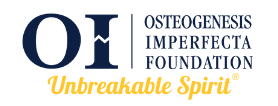SHARE
Differential Diagnosis: Brittle Bone Conditions Other than OI
Fragile bones are the hallmark feature of osteogenesis imperfecta (OI). The mutations that cause OI lead to abnormalities within bone that result in increased bone turnover; reduced bone mineral content and decreased bone mineral density. The consequence of these changes is brittle bones that fracture easily. But not all cases of brittle bones are OI. Other causes of brittle bones include osteomalacia, disuse osteoporosis, disorders of increased bone density, defects of bone, and tumors.
The following is a list of conditions that share fragile or brittle bones as a distinguishing feature. Brief descriptions and sources for further information are included.
|
Bruck Syndrome |
This autosomal recessive disorder is also referred to as OI with contractures. Some people now consider this to be a type of OI. National Library of Medicine Genetics Home Reference: http://ghr.nlm.nih.gov
|
|
Ehlers-Danlos Syndrome (EDS) |
Joint hyperextensibility with fractures; this is a variable disorder caused by several gene mutations. Ehlers-Danlos National Foundation http://www.ednf.org
|
|
Fibrous Dysplasia |
Fibrous tissue develops in place of normal bone. This weakens the affected bone and causes it to deform or fracture. Fibrous Dysplasia Foundation: https://www.fibrousdysplasia.org
|
|
Hypophosphatasia |
This autosomal recessive disorder affects the development of bones and teeth through defects in skeletal mineralization. Soft Bones: www.softbones.org; National Library of Medicine Genetics Home Reference: http://ghr.nlm.nih.gov/condition
|
|
Idiopathic Juvenile Osteoporosis |
A non-hereditary transient form of childhood osteoporosis that is similar to mild OI (Type I) National Osteoporosis Foundation: www.nof.org
|
|
McCune-Albright Syndrome |
This disorder affects the bones, skin, and several hormone-producing tissues. National Library of Medicine Genetics Home Reference: http://ghr.nlm.nih.gov/condition
|
|
Osteopetrosis |
Bone is abnormally dense but fractures easily. The OsteoPETrosis Society www.osteopetrosis.org
|
|
Osteoporosis-Pseudoglioma Syndrome (OPPG) |
A autosomal recessive disorder that is characterized by short stature, fractures, and blindness. It is sometimes referred to as OI with early on-set blindness. Windows of Hope: www.wohproject.org
|
|
Rickets |
In Rickets soft and weak bones are caused by lack of vitamin D, calcium and phosphate. It can be hereditary, or due to problems in the diet (insufficient calcium) or environment (insufficient vitamin D from sunlight or diet). Breastfed infants often receive vitamin D supplements to prevent rickets. The US National Library of Medicine: www.nlm.nih.gov |
|
Additional Considerations |
|
|
Prematurity |
Premature infants may be osteopenic – their bone mineral density is lower than normal but not low enough to be classified as osteoporosis.
|
|
Child Abuse
|
OI, particularly the mild and moderate forms, may be mistaken for child abuse or non-accidental trauma in infancy and early childhood. When there are no other signs of abuse or neglect, the OI Foundation recommends considering the fractures as a reason to do a thorough evaluation considering the whole range of fragility disorders. Genetic testing may be necessary to confirm a clinical diagnosis.
|
|
Malabsorption Syndromes |
Various conditions including celiac disease lead to the person’s inability to make use of important nutrients such as copper, magnesium, calcium or vitamin D. All can contribute to making bones unusually fragile and prone to breaking.
|
|
Osteoporosis |
The weak and fragile bones of post-menopausal osteoporosis occur when the making of new bone does not keep up with the removal of old bone. |
